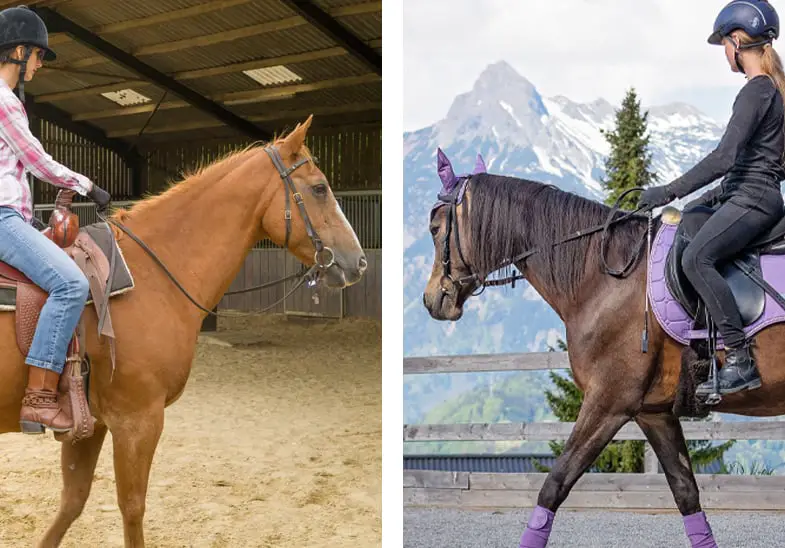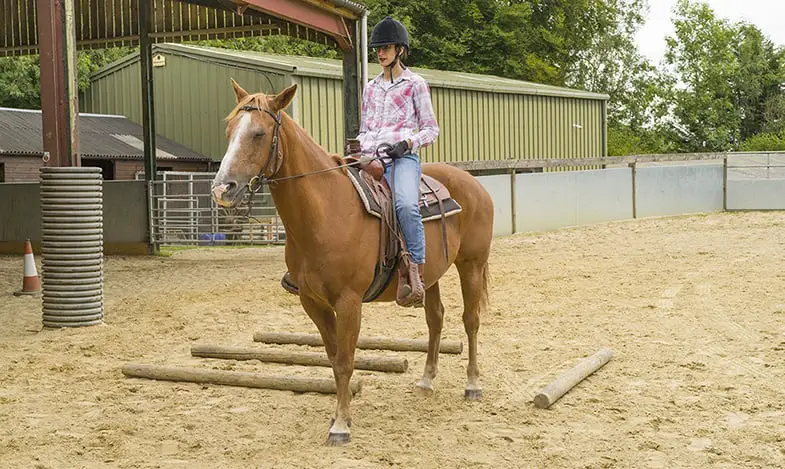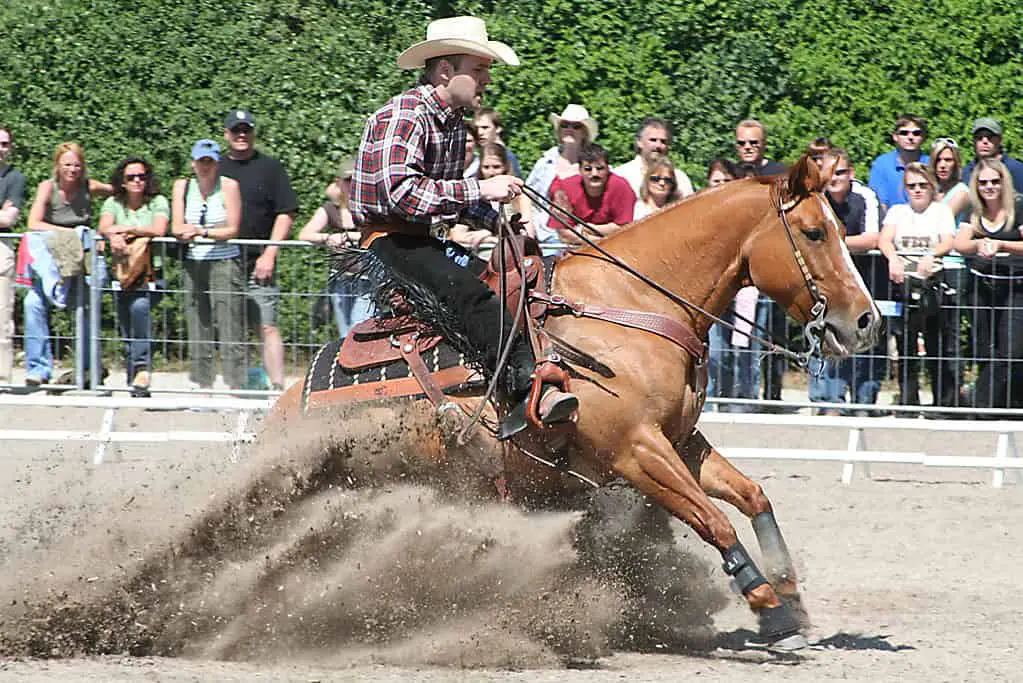Learning to ride a horse is great fun but horses are big animals that can cause a lot of damage if you’re not able to control them properly which is why it’s vital you learn how to stop them correctly. To some extent, it’s the most important lesson you’ll learn and is certainly the first thing I always teach my students, even before they learn how to get a horse to walk.
While it might seem strange at first, learning anything new takes time, and learning how to stop a horse is no exception. At first, everything will seem alien and unnatural but in time (and with practice) you’ll be able to stop your horse without even thinking about it.
How do you stop a horse?
It’s a popular misconception that in order to stop a horse all you need to do is yank on the reins, but while this may work it will cause your horse a lot of pain. If it does work it’ll only be a short-term solution, in the long term you’ll end up with a horse that pulls on the reins a lot and resists your commands. This is why it’s better to learn how to stop a horse properly using your whole body.
While you can stop a horse from any pace it’s always better to start learning how to stop them from a walk. This will help you to learn how to stop them gently and correctly before you progress to stopping them at other paces.
Reins
Before you even think about stopping your horse it’s important to make sure your reins are correct. They shouldn’t have so much slack that your horse could trip over them, nor should they be so short that your horse’s nose is touching his chest.
If you’re riding western then the reins should have a little bit of slack in them while English reins tend to be tighter and have less slack. Likewise, the reins should be even on both sides otherwise you’ll end up turning the horse instead of stopping them.
Engage your stomach muscles
It might not be so easy to do at first but if you can tighten your stomach muscles (without tensing your back too) your horse will sense your body tense up and will understand that you’ll soon ask him to stop.
TIP: If you find it difficult to engage your stomach muscles try imagining a piece of string (which is attached to your belly button) being pulled towards your back. Practicing this out of the saddle will help too but try to remember to breathe as well!
Weight
Horses are very sensitive to the position of your body which is why shifting your weight is so important. As you shift your weight deep into the saddle, pushing your tailbone downwards and sitting towards the back of your bottom (as if you’re sitting on your back pockets) you’ll be out of sync with your horse’s movement. This will cause your horse to slow down which is the first step to getting him to stop.
Shoulders
While you’ll ultimately use your hands to stop your horse the signal will begin in your shoulders which is why they need to be relaxed. As you shift your weight downwards it can be easy to tense your shoulders but they should be relaxed, back and square.
Back
Like your shoulders, your back should be upright and relaxed. Tensing up or leaning back will unbalance you and end up making causing you to tense up even more.
Hips
When your horse is moving forward you’ll naturally move your hips in time with them, but when it comes to stopping them you need to also stop your hips from moving. Sometimes referred to as being frozen in place, this lack of movement in your hips is similar to shifting your weight; it’s another cue to your horse that you’re going to ask him to stop.
Knees and thighs
It may seem counterintuitive to tense your legs when you’re asking him to stop, but tightening your knees and thighs against the saddle (without gripping) lets your horse know you’re going to ask him to stop. The reason for this is that you’re lack of movement in the saddle will cause your horse to adjust his pace to match yours.
Feet
Other than the length of the reins, the position of your feet is the only other difference between Western and English riding. If you’re riding western then you should move your feet forward as if you’re about to stop yourself, similar to how you’d brake in a car (except with both feet). With English riding your feet should remain where they are.
Regardless of your riding style, your heels should still be down, this will help you to keep your weight deep in the saddle but will also help to keep you balanced.
Hands
When you’re learning to stop a horse you should hold the reins in both hands and use them both to help stop your horse (you can always use one hand as you become more experienced).
Gently, but firmly use both hands to increase the grip on the reins and bring them back towards your stomach. It can be all too easy to raise your hands and bring them back but it’s important to keep them low otherwise you could hurt your horse’s mouth.
If your horse doesn’t stop you can increase the pressure on the reins a little but you should release it as soon as he does stop.
Voice
If your horse has been trained to respond to verbal cues then you can also use this in conjunction with the rest of the other aids.
Once your horse has stopped
As soon as your horse has stopped you should release the pressure on the reins and relax your body, returning your weight to the front of your seat and loosening the tension in your legs.
What should you do if the horse won’t stop?
If your horse doesn’t stop straight away then you can try applying a little bit more pressure to the reins but don’t get into a tug of war with the horse, believe me, you won’t win. Instead, if that still doesn’t work try releasing the pressure before reapplying it. Continue doing this in waves until the horse slows and ultimately stops.
Is your horse always bolting? How to stop a horse bolting, permanently.
Fine-tuning the stop
You might think that once a horse has stopped that’s it and you can just dismount but if they’re not standing squarely (with a leg in each corner) then you could injure yourself or the horse. Instead, it’s better to ‘correct’ your horse’s position slightly before dismounting.
You can do this easily by applying a little bit of pressure to the leg that’s sticking out or isn’t straight. This will encourage them to straighten up but it’s important you release the tension as soon as they have.
What do you say to a horse to get them to stop?
A lot of people use voice commands (known as verbal cues) to help stop their horse but, while this is a good idea it should only be used to reinforce your physical cues. The reason for this is that if you intend to show your horse you won’t be able to use any verbal cues in the show ring.
If you do use a verbal cue then whoa is the most commonly used one, it’s short, sharp, and to the point. It’s quick and easy to say. It also signals to the horse to stop immediately but doesn’t create any unnecessary fear. That said, halt, hoa, and stop are also regularly used.
Whatever command you use though you should use it in a low, calm, and drawn-out tone that’s loud enough for the horse to hear. Horses are prey animals and can easily be spooked so suddenly shouting won’t work and will likely have the opposite effect.
What you SHOULDN’T do when stopping a horse
As a riding instructor, I know it’s easy to focus on what you should do but sometimes we need to make it clear what you shouldn’t do and which is why I decided to include this section.
DON’T pull sharply on the reins and don’t jab at them either. Horses have very sensitive mouths which is why you should always use the least amount of pressure necessary. If your horse throws his head up it’s a sign you’re pulling too sharply on the reins.
DON’T pull on the reins and kick at the same time. This will only confuse your horse and he won’t know what you want him to do.
DON’T give your horse mixed messages, make sure you give clear, concise, and consistent commands. Horses try their best to do what we want them to do but can get frustrated if they don’t understand what you’re asking them to do.
What next? Now that you’ve learned to stop it’s time to learn how to ride a horse at a walk.
Related questions
How do you get a horse to go backward?
If you’ve stopped your horse but need to go back a bit further you can easily back them up instead so don’t worry.
To do this pull back firmly, but not sharply, on the reins and most horses (especially ones that have been western-trained) will start to walk backward (known as backing up). While you might think using your legs will encourage your horse to go back it won’t work – legs mean forward.
Once you’ve got your horse where you want them to be release the pressure on your reins.
How do you get a horse to slide to a halt?
If you’ve ever seen a reining competition you’ll have noticed how they skid the horses to a halt, spraying dust as they go, but how do they do that?
Unlike stopping a horse in everyday life, with sliding stops the horse responds solely to verbal cues. To start with the horse needs to be loping without any physical cues from you. When you’re ready to stop your horse you need to sit back, keep your eyes up, your shoulders back, and say whoa. If the horse has been trained correctly then they should drop their hindquarters and skid to a halt.
While not all horses use them, most reining horses use special shoes (ones that have slider plates) to help them slide to a halt.
I hope you found this article helpful. If you did I’d be grateful if you could share it please as it would really help me.
Recommended products
Over the years I have tried hundreds of different horsey products, from various blankets and halters to different treats. Some I’ve loved, others I’ve hated but I thought I’d share with you my top all-time favorite products, the ones I never leave the yard without. I’ve included links to the products (which are in no particular order) that I really think are great.
- Horse Knots by Reference Ready – If you’re like me and enjoy pocket reference guides then you’ll love this knot tying guide. These handy cards can easily fit in your pocket or attach to the saddle for quick reference. They’re waterproof, durable and are color coded to make them easy to follow.
- Mane ’n Tail Detangler – Even if you never show your horse you’ll need to detangle his tail from time to time (and possibly his mane too) which is always a challenging chore! I’ve found that if I run a little bit of detangler through my horse’s tails every few days it stops them from getting matted up and makes combing them easy, even if they’re coated in mud. I don’t know if I should admit to this or not but it also works wonders on my hair.
- TAKEKIT Pro clippers – Over the years I’ve tried a lot of different clippers and while some were obviously better than others I found these to be by far the best. They are heavier than a lot of other clippers but for me, that’s a good thing, it makes them feel more sturdy and hardwearing. On top of that they have a range of speeds so are just as good for clipping your horse’s back as they are his face. I also like the fact that they come in a handy carry case but that’s not for everybody. The company that makes them is super good and incredibly helpful too, a real bonus these days. The only thing I wasn’t keen on was the fact that it doesn’t come with any oil, but that’s not a major problem as it’s not difficult to buy lubricant.
- Shire’s ball feeder – There are so many boredom buster toys out there but I like to use these every day, regardless of whether or not my horses are bored. I find that it helps to encourage my horses to problem solve by rewarding them with treats (or pieces of fruit) but it also mimics their natural grazing behavior which helps to keep them calm and de-stressed.
- Horse safe mirror – This is a strange one that many people are surprised about but I like to put horse safe mirrors in the trailers as well as in the quarantine stalls. It helps to prevent the feeling of isolation by giving the impression of other horses being around. Being herd animals horses can get extremely stressed when they feel that they’re on their own but with these stick-on mirrors, they believe that at least one other horse is with them.
- Rectal thermometer – I know this isn’t glamourous at all but it’s vital for your horse’s well-being to be able to check their temperature and a rectal thermometer is the easiest way of doing this which is why I’ve added it to the list.
Shopping lists
I’ve also put together a few shopping lists of essential items that I’ve found helpful over the years. I’ve broken the lists down into different categories rather than put everything in one massive list 😉




